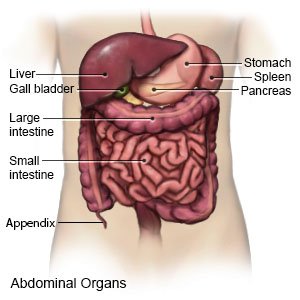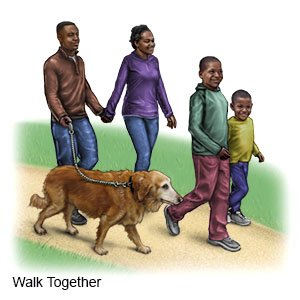Abdominal pain may be felt between the bottom of your rib cage and your groin. Acute pain usually lasts less than 3 months. Chronic pain lasts longer than 3 months. Your pain may be sharp or dull. The pain may stay in the same place or move around. You may have the pain all the time, or it may come and go. Depending on the cause, you may also have nausea, vomiting, fever, or diarrhea.

What causes abdominal pain?
The cause may not be found. The following are common causes of abdominal pain:
- Overeating, gas pains, or food poisoning
- Constipation or diarrhea
- An injury
- A serious health problem, such as appendicitis, a hernia, or an ulcer
- Infection or a blockage
- A liver, gallbladder, or kidney condition
How is the cause of abdominal pain diagnosed?
Your healthcare provider will check your abdomen. He or she will ask where your pain is and when it started. Tell him or her if the pain wakes you or stops you from doing your daily activities. Describe anything that makes the pain better or worse. You may also need any of the following:
- Blood, urine, or bowel movement samples may be tested for signs of an infection, disease, or injury.
- X-ray pictures of your abdomen may show an injury or other cause of the pain.
How is abdominal pain treated?
- Prescription pain medicine may be given. Ask your healthcare provider how to take this medicine safely. Some prescription pain medicines contain acetaminophen. Do not take other medicines that contain acetaminophen without talking to your healthcare provider. Too much acetaminophen may cause liver damage. Prescription pain medicine may cause constipation. Ask your healthcare provider how to prevent or treat constipation.
- Medicines may be given to calm your stomach or prevent vomiting.
- Relaxation therapy may be used along with pain medicine.
- Surgery may be needed, depending on the cause.
What can I do to manage my symptoms?
- Apply heat on your abdomen for 20 to 30 minutes every 2 hours for as many days as directed. Heat helps decrease pain and muscle spasms.
- Make changes to the food you eat, if needed. Do not eat foods that cause abdominal pain or other symptoms. Eat small meals more often. The following changes may also help:
- Eat more high-fiber foods if you are constipated. High-fiber foods include fruits, vegetables, whole-grain foods, and legumes.

- Do not eat foods that cause gas if you have bloating. Examples include broccoli, cabbage, and cauliflower. Do not drink soda or carbonated drinks. These may also cause gas.
- Do not eat foods or drinks that contain sorbitol or fructose if you have diarrhea and bloating. Some examples are fruit juices, candy, jelly, and sugar-free gum.
- Do not eat high-fat foods. Examples include fried foods, cheeseburgers, hot dogs, and desserts.
- Limit or do not have caffeine. Caffeine may make symptoms such as heartburn or nausea worse.
- Drink more liquids to prevent dehydration from diarrhea or vomiting. Ask your healthcare provider how much liquid to drink each day and which liquids are best for you.
- Keep a diary of your abdominal pain. A diary may help your healthcare provider learn what is causing your abdominal pain. Include when the pain happens, how long it lasts, and what the pain feels like. Write down any other symptoms you have with abdominal pain. Also write down what you eat, and what symptoms you have after you eat.
- Manage your stress. Stress may cause abdominal pain. Your healthcare provider may recommend relaxation techniques and deep breathing exercises to help decrease your stress. Your healthcare provider may recommend you talk to someone about your stress or anxiety, such as a counselor or a trusted friend. Get plenty of sleep and exercise regularly.
- Do not smoke. Nicotine and other chemicals in cigarettes can damage your esophagus and stomach. Ask your healthcare provider for information if you currently smoke and need help to quit. E-cigarettes or smokeless tobacco still contain nicotine. Talk to your healthcare provider before you use these products.
Limit or do not drink alcohol. Alcohol can make your abdominal pain worse. Ask your healthcare provider if it is safe for you to drink alcohol. Also ask how much is safe for you to drink.

Call your local emergency number (911 in the US) if:
- You have new chest pain or shortness of breath.
When should I seek immediate care?
- You have pulsing pain in your upper abdomen or lower back that suddenly becomes constant.
- Your pain is in the right lower abdominal area and worsens with movement.
- You have a fever over 100.4°F (38°C) or shaking chills.
- You are vomiting and cannot keep food or liquids down.
- Your pain does not improve or gets worse over the next 8 to 12 hours.
- You see blood in your vomit or bowel movements, or they look black and tarry.
- Your skin or the whites of your eyes turn yellow.
- You are a woman and have a large amount of vaginal bleeding that is not your monthly period.
When should I call my doctor?
- You have pain in your lower back.
- You are a man and have pain in your testicles.
- You have pain when you urinate.
- You have questions or concerns about your condition or care.
